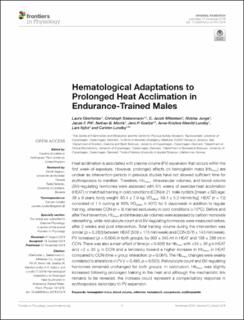| dc.contributor.author | Oberholzer, Laura | |
| dc.contributor.author | Lundby, Carsten | |
| dc.contributor.author | Siebenmann, Christoph | |
| dc.contributor.author | Mikkelsen, CJ | |
| dc.contributor.author | Junge, N | |
| dc.contributor.author | Piil, JF | |
| dc.contributor.author | Morris, NB | |
| dc.contributor.author | Goetze, JP | |
| dc.contributor.author | Lundby, AK | |
| dc.contributor.author | Nybo, Lars | |
| dc.date.accessioned | 2020-04-01T12:58:57Z | |
| dc.date.available | 2020-04-01T12:58:57Z | |
| dc.date.created | 2020-02-11T07:26:06Z | |
| dc.date.issued | 2019 | |
| dc.identifier.citation | Frontiers in Physiology. 2019, 10, (1379) | en_US |
| dc.identifier.issn | 1664-042X | |
| dc.identifier.uri | https://hdl.handle.net/11250/2649912 | |
| dc.description | Frontiers is fully compliant with open access mandates, by publishing its articles under the Creative Commons Attribution licence (CC-BY). Authors retain copyright of their work and can deposit their publication in any repository. The work can be freely shared and adapted provided that appropriate credit is given and any changes specified. | en_US |
| dc.description.abstract | Heat acclimation is associated with plasma volume (PV) expansion that occurs within the first week of exposure. However, prolonged effects on hemoglobin mass (Hbmass) are unclear as intervention periods in previous studies have not allowed sufficient time for erythropoiesis to manifest. Therefore, Hbmass, intravascular volumes, and blood volume (BV)-regulating hormones were assessed with 5½ weeks of exercise-heat acclimation (HEAT) or matched training in cold conditions (CON) in 21 male cyclists [(mean ± SD) age: 38 ± 9 years, body weight: 80.4 ± 7.9 kg, VO2peak: 59.1 ± 5.2 ml/min/kg]. HEAT (n = 12) consisted of 1 h cycling at 60% VO2peak in 40°C for 5 days/week in addition to regular training, whereas CON (n = 9) trained exclusively in cold conditions (<15°C). Before and after the intervention, Hbmass and intravascular volumes were assessed by carbon monoxide rebreathing, while reticulocyte count and BV-regulating hormones were measured before, after 2 weeks and post intervention. Total training volume during the intervention was similar (p = 0.282) between HEAT (509 ± 173 min/week) and CON (576 ± 143 min/week). PV increased (p = 0.004) in both groups, by 303 ± 345 ml in HEAT and 188 ± 286 ml in CON. There was also a main effect of time (p = 0.038) for Hbmass with +34 ± 36 g in HEAT and +2 ± 33 g in CON and a tendency toward a higher increase in Hbmass in HEAT compared to CON (time × group interaction: p = 0.061). The Hbmass changes were weakly correlated to alterations in PV (r = 0.493, p = 0.023). Reticulocyte count and BV-regulating hormones remained unchanged for both groups. In conclusion, Hbmass was slightly increased following prolonged training in the heat and although the mechanistic link remains to be revealed, the increase could represent a compensatory response in erythropoiesis secondary to PV expansion. | en_US |
| dc.language.iso | eng | en_US |
| dc.subject | hemoglobin mass | en_US |
| dc.subject | blood volume | en_US |
| dc.subject | critmeter | en_US |
| dc.subject | hematocrit | en_US |
| dc.subject | vasopressin | en_US |
| dc.subject | erythropoietin | en_US |
| dc.title | Hematological Adaptations to Prolonged Heat Acclimation in Endurance-Trained Males. | en_US |
| dc.type | Peer reviewed | en_US |
| dc.type | Journal article | en_US |
| dc.description.version | publishedVersion | en_US |
| dc.source.journal | Frontiers in Physiology | en_US |
| dc.identifier.doi | https://doi.org/10.3389/fphys.2019.01379 | |
| dc.identifier.cristin | 1792853 | |
| cristin.unitcode | 209,4,4,0 | |
| cristin.unitname | Idrettshøgskolen Innlandet | |
| cristin.ispublished | true | |
| cristin.fulltext | original | |
| cristin.qualitycode | 1 | |
